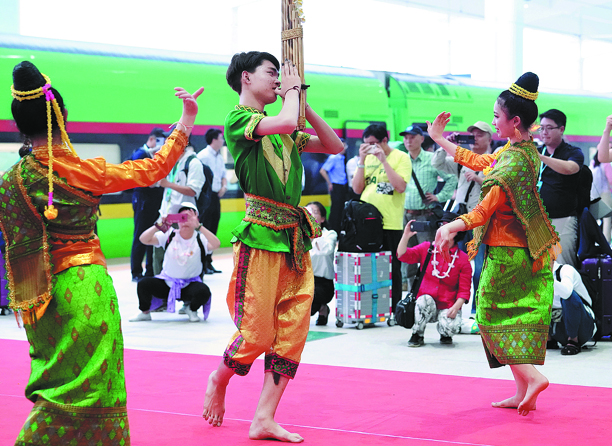Railway turns Laos from landlocked to land-linked


China and Laos are collaborating to facilitate quicker cross-border customs clearance between the two countries to enhance railway transportation efficiency, said a diplomat of the Lao embassy in China.
Chindavong Xaiyasin, counselor of education and culture at the Lao embassy in China, disclosed in an exclusive interview with China Daily that Laos' deputy minister of foreign affairs visited Beijing last week to explore ways to further reduce the time taken to clear customs when traveling by train.
The ongoing discussions focus on cutting border port clearance time from two hours to one, Xaiyasin said.
The China-Laos Railway began operations in December 2021, and cross-border passenger services began in April 2023. The 1,035-kilometer electrified line links Kunming, the capital of Yunnan province, with Vientiane, the capital of Laos.
When passenger services started in 2023, it took a combined three hours to clear customs at the railway ports of Mohan in China and Boten in Laos.
Mohan port established an office and initiated a 24-hour green channel dedicated to expediting clearance procedures for the China-Laos Railway.
By July, due to collaborative efforts between China and Laos, the total clearance time was reduced from three hours to two. This resulted in a 64-minute reduction in travel duration, with the total journey time from Kunming to Vientiane now taking 9 hours and 26 minutes, according to the train schedule of China Railway Kunming Group.
The increasingly efficient China-Laos Railway is fueling Laos' growth and revitalizing trade and economy in Southeast Asia, Xaiyasin said.
Laos, a landlocked country in Southeast Asia, had long struggled with expensive transportation that limited its trade and development.
"Laotian people had never seen trains. Until I went to school in China at the age of 15, I had not seen a train car," Xaiyasin said during a meeting at the Communication University of China last week.
Ever since the country became independent in the 1960s, a railway network has been the demand of the people of Laos. President Xi Jinping responded to this demand in 2015, when leaders of the two countries made a major decision to build the China-Laos Railway.
"With the railway, the mountain from Kunming to Vientiane is no longer high, and the road no longer long," Xi said at the railway's opening ceremony. He expressed the hope that the railway would develop into "a golden line for the benefit of the people of both countries".
Benefiting from the project under the China-proposed Belt and Road Initiative, the people of Laos are seeing opportunities being created by the railway that links the country with China and the rest of the world, according to Xinhua News Agency.
A World Bank estimate said the China-Laos Railway could reduce domestic transportation costs by 20 to 40 percent in Laos, and cut cross-border transportation costs between Kunming and Vientiane by 40 to 50 percent.
Last month, the integration of the China-Laos Railway and the China-Europe Railway Express project established a new international logistics route, reducing transportation time between Southeast Asia and Europe to approximately 15 days.
"The railway fulfills Laos' strategy, transforming the country from landlocked to land-linked," Xaiyasin said at the sharing session.
He said that Laos and China are now paying close attention to personnel training to ensure the sustainable operation of the railway network.
In 2022, Laos sent 40 students to Kunming Railway Vocational and Technical College in Yunnan. They have now returned to Laos after completing 18 months of study, and are ready to guide the next generation of transportation professionals, Xaiyasin said.
Bai Wengang, a professor of government and public affairs at the Communication University of China said, "The China-Laos Railway tells us that the Chinese path to modernization is not just about China's own development, but also about fostering the development of our neighbors."
He added that the country should embrace all ethnicities and cultures to create what President Xi called a shared future for China-Laos community, for Asian community and for global community.
































